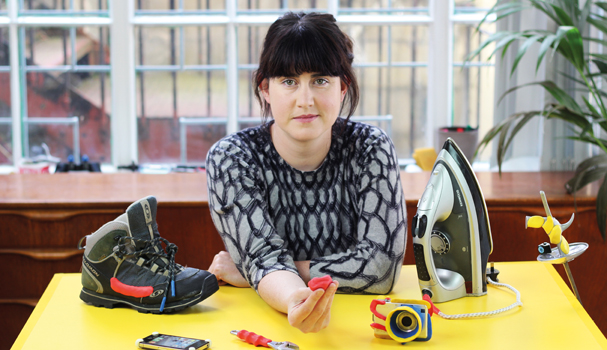Many of our greatest consumer products these days are collaborative efforts, only made possible by the connected intellect of generations of designers and thinkers. Finding a bona fide invention, created from scratch that, nonetheless, stands a good chance of becoming a part of our everyday lives, is rare indeed.
Sugru is such a product. A self-setting rubber that can bond to practically any surface, it allows the user to easily repair and modify household items, knocking Blu-Tack, Polyfilla and Sellotape into a cocked hat. Already, sugru has survived trips to the North Pole and into space, built up a loyal fan-base of product-hackers, DIYers and kids and received rave reviews and accolades alike.
As can be inferred from the community that has sprung up around it, the drive behind sugru has always been about putting control back in the consumer’s hands. “I grew up on a farm, so for me that sort of way of life, make do and mend, is very normal,” says inventor and co-founder Jane Ní Dhulchaointigh. In a world where most things are intended to be discarded the moment they’re no longer fit for purpose, she believes people feel let down by the lack of emotional connection.
“If you think about the stuff that means something to you, it’s usually something you’ve either had for a long time, you’ve taken care of or it’s been passed to you from somebody else,” she explains. “I wanted to design something that would basically encourage that and make it fun and easy for people to repair and customise things.”
This taste for the aesthetic isn’t all that surprising, given that originally Ní Dhulchaointigh studied sculpture, before moving into a masters degree in product design at the Royal College of Art. However, she didn’t want to just combine existing materials to create another new product that would be released and, before long, forgotten. Instead, she decided she wanted to experiment with the materials themselves – something most people would find daunting without a firm background in chemistry. “I was extremely naive and probably still am,” Ní Dhulchaointigh admits. “I regard that sort of naivety as actually quite an asset as I didn’t really see the barriers or how long it would take.”

Sugru may have seemed rather inauspicious in its first form. Initially an experiment blending silicon sealant and waste wood powder, it left Ní Dhulchaointigh with something of a mess on her hands. “It was an extremely smelly and horrible thing to do but for some reason I did it,” she comments. However, with a faint echo of Charles Goodyear’s serendipitous discovery of vulcanisation, a gooey mess hid a rather striking secret. “I left it for an hour; when I came back the mixture turned from a dough-like consistency to bouncy rubber,” she says. “There was something there that was amazing.”
While it was certainly an intriguing discovery, it was far from a finished product. “Working with it was obviously very messy and not a very nice experience,” says Ní Dhulchaointigh.
Sugru had some very exciting properties but an important influencing factor for the inventor and entrepreneur was putting herself in the shoes of her consumers and the impact she wanted to create. “A key part of sugru was to give the impression of it being magic,” she explains. “That required a certain design of the material to have the sense that you can do anything or that it can stick to anything.”
And thus began a long development period. While the technological process was being ironed out, Ní Dhulchaointigh and her co-founders, Roger Ashby and James Carrigan, began to consider their route to market, something inevitably influenced by Ashby’s experience licensing technologies unearthed in universities into large industry. “We were thinking really big,” she explains. “We believed that sugru had the potential to be a universal household product like Blu-Tack or duct tape.”
It certainly wasn’t met with a lack of interest from some of the industry’s best and brightest. Unfortunately, while all-comers recognised that sugru was an innovative and disruptive product, there were simply easier ways for the giants to make money. “Sugru is something that I think is still slightly ahead of its time – back when I started in 2004, nobody was talking about fixing and mending things,” she explains. “That only started when the recession hit and then people realised that actually all of this consumer stuff isn’t really what it’s cracked up to be.”
While the meetings were incredibly useful in guiding and inspiring the development process, it eventually became clear that licensing wasn’t going to offer the best route to market, particularly when the recession hit in 2008 and the funds began to dry up. Fortunately, a shift in focus would ultimately become one of the enterprise’s greatest assets.

“At a real low point I met a real friend of mine for a coffee and she gave me the best piece of advice I’ve ever been given,” says Ní Dhulchaointigh. “It was, ‘I know you want this to be big but don’t start there; start small. If you can make this work for ten people, you can make it work for 100. If you make it work for 100, it can go to 1,000.’ That was a real eye-opener for me.”
The team revised their investment targets and secured a smaller amount of funding from an angel investor, setting themselves the challenge of building organically to a six-month launch. Friends and associates with experience in social media helped to forge a presence for sugru online while the team refocused on what it was that made their brand strong.
“I was thinking, ‘What should this product be? What is this brand?’” recalls Ní Dhulchaointigh. And it was clear that rather than being something drab and functional, the whole focus of the as-yet-unnamed product needed to be about being able to play around with the things that surround you and make something new. “Sugru is the Irish word for ‘play’,” says the entrepreneur. “It’s about taking things into your hands and having fun solving problems.”
This new approach was a masterstroke. Rather than telling the consumer what they should do with the product, sugru put everything in their hands, inviting them to freely explore all the things for which they could use the mouldable, adhesive rubber. “The whole way we launched it was not telling people what to do but asking, ‘What would you do with it? What’s your problem?’” comments Ní Dhulchaointigh. “Then people would share their photos and inspire each other with what they could do.”
At the time, the team couldn’t have possibly known quite how far this would take them. When they finally sent out the product to selected bloggers and journalists, initial responses were limited. But then they found an unexpected benefactor in Daily Telegraph journalist Harry Wallop. Ní Dhulchaointigh recalls: “He said, ‘the stuff sounds brilliant – bring it over, I’ll give it a try and review it for you.’” The day before the product’s launch, Wallop’s video review hit the web – he’d given the product ten out of ten.

The team had spent two months making a thousand packs of sugru for their launch. Such was the impact of Wallop’s review, every last pack sold within six hours. “It was amazing,” says Ní Dhulchaointigh. “That day just transformed everything because it told us there were customers for this and people who were as excited as us.” With this vindication, the team were able to secure more funding and begin to scale up production.
And since then, the sugru team has scarcely had a chance to draw breath, seeing a nigh on constant influx of interest. Not only has the product netted its inventor the London Design Festival Design Entrepreneur award but the press attention it has garnered has been huge, including its inclusion in Time Magazine’s 50 Best Inventions of 2010 – the iPad ranked at just 34 while sugru was placed at a lofty 22.
“They asked, ‘How often does an invention come along that is not full of really high-tech stuff but is something that is small and humble yet can make a difference in millions and millions lives over generations?’” says Ní Dhulchaointigh.
But it’s the response they’ve had from their customers that has really made the most impact, confirming that the time for products like sugru has come. “Technology in general is being democratised,” Ní Dhulchaointigh comments. “That’s what we’re part of.” With technology such as 3D printing become cheaper and more readily available, possessions that consumers have played a part in creating are completely changing the way we view value. As its inventor comments: “The whole reason for sugru is because people are feeling like, ‘Where’s the soul in these things?’”
It’s still early days for sugru and its community of product-hackers, modders, menders and creatives but, given its reception so far, it seems likely it’s going to become a firm fixture in a lot of people’s lives. ![]()
Share via:


















































